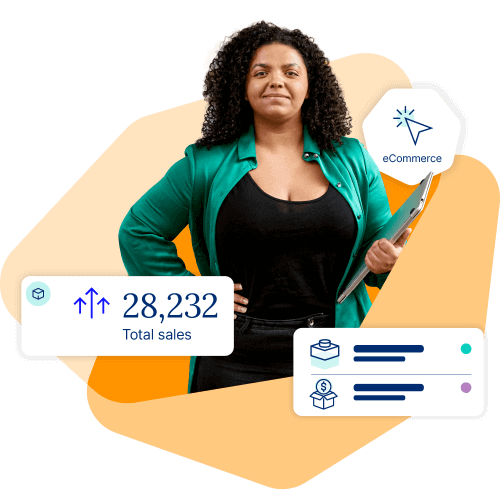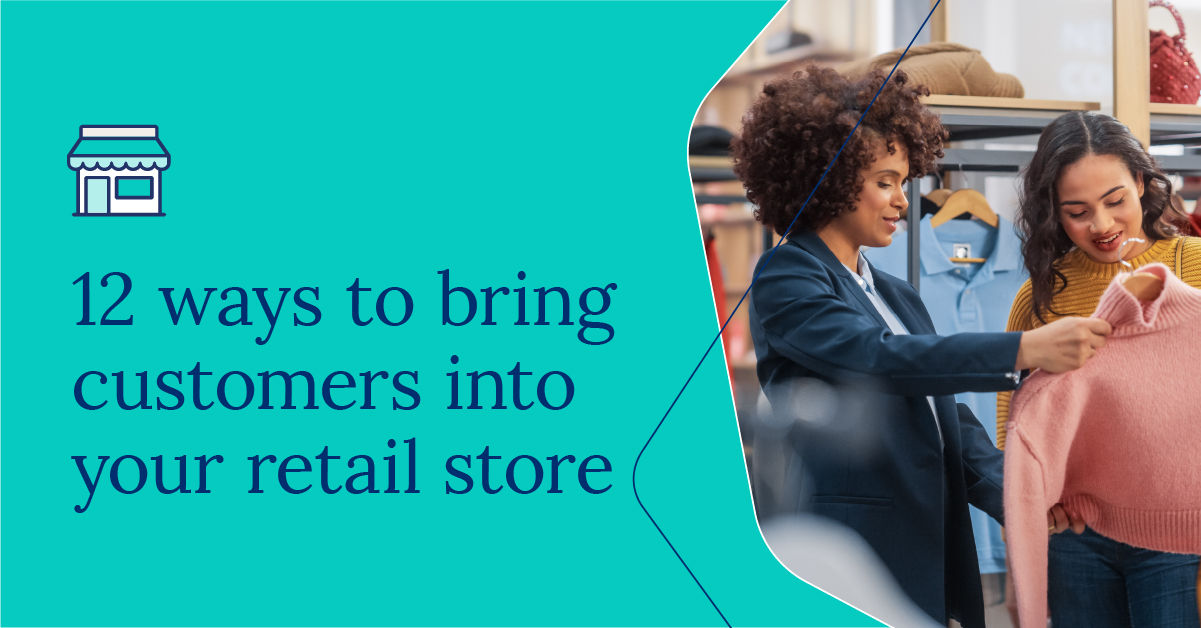

The last few years have been really hard for retailers. Disruptions from the Covid-19 pandemic forced many businesses to slow or halt operations altogether. Factory shutdowns created a production backlog, with 38.8% of small businesses facing delays from suppliers, according to the US Census Bureau. At the same time, consumer demand for many products spiked as people panicked about the future, making it difficult for retailers to meet demand.
Today, there are new challenges for retailers. The Russia-Ukraine conflict has destabilized the energy and commodity markets. Labor shortages have made it difficult to find workers, and inflation is at 40 year highs. In fact, in a survey conducted by Small Business for America’s Future (SBAF) 60 percent of 1,576 small business owners said that inflation is their top challenge.
Inflation makes it expensive to replenish your inventory from suppliers. You need to either raise your budget to get the same level of inventory that you got before the inflationary period, or you must lower your order quantity.
It is important to be strategic about your inventory, as piling up unsold inventory raises storage costs and freezes your working capital.
ABC analysis is a popular inventory classification method that can help you sort your inventory. It helps identify the critical SKUs that generate the majority of revenue for your business.
To learn more about ABC analysis, refer to our detailed guide.
Using your sales data, you can eliminate underperforming SKUs. You can channel your working capital to acquire the best sellers by removing the bad ones. To ensure that you don’t overstock underperforming products, it is important to always have a clear picture of what is in your inventory.
Cin7 inventory management software offers advanced reporting features that can improve your inventory planning. In addition to inventory tracking, you can gauge the performance of your SKUs and forecast the demand accordingly. With the right data at your fingertips, you can make better decisions around inventory replenishment and avoid overstocking situations.
Using specialized inventory management software can be a gamechanger for multichannel sales.
Without inventory management software, you’ll have to manually allocate inventory for your offline and online stores, which can lead to a loss in opportunities. For instance, say you sell smartphones on Amazon, Shopify, and your bricks-and-mortar store. If you have 100 units of iPhone 13 ready to sell, then you have two options:
Option 1: Placing maximum inventory for all channels
In this option, you put the same quantity (100) on the online and offline store. The problem is if you receive 60 orders online and 60 orders offline at the same time, you cannot fulfill all the orders as you have oversold your inventory. You have a total of 100 units, but the ordered quantity is 120.
Option 2: Dividing the inventory
Another option is to divide the inventory across all the channels. You can allocate 33 units for Amazon, 33 units for Shopify, and 34 units for your offline store. In this case, the issue is underselling. If someone wants to place an order of 50 units on Amazon, but you’ve listed only 33 units, you’ll miss out on potential sales despite having inventory in your backend.
An inventory management solution saves you from the trouble of allocating inventory. It syncs your inventory in real-time, so if you receive 60 orders from Amazon, it automatically reduces the available inventory to 40 in Shopify and your offline point-of-sale system.
In addition to multi-channel sales, offering omnichannel support (i.e., unifying the online and offline buying experience) can sweeten the pot. Joe Troyer (CEO of Review Grower) says, “Customers are smoothly switching between online and offline experiences, and they are willing to shop at businesses that can make this transition as simple as possible. In-store research and showrooming, the practice of inspecting a product in-store only to make the buy online, are now more widespread than ever thanks to the development of mobile retail.
By incorporating real-time feedback across channels and devices and engaging the customer wherever they may be, they may use the right customer data to build an omnichannel customer experience that enables consumers to participate whenever and however they choose.”
You should carefully monitor the actions of your close competitors. Ask:
The insights you collect will help you in determining the price changes in the market so that you can maintain price parity.
For those who are pondering over offering products much cheaper than the competition, with the intent of attracting their customers — this can backfire. For instance, low pricing might signal that your quality is inferior to your competitors (tarnishing your brand image). Additionally, increasing your sales volume by reducing prices doesn’t necessarily lead to higher profits when there is inflation.
Being strategic in what you outsource can be of immense help in reducing your operational costs and freeing up working capital. You should focus on cutting costs without sacrificing the product’s quality.
Third-party logistics (3PL) providers are businesses that take care of an organization’s supply chain and logistical operations. 3PL providers can offer a lot of fulfillment services such as
If you do all this on your own, you will incur the hassle of setting up your warehouse, hiring and training employees to fulfill the orders efficiently, managing payroll, and maintaining the warehouse. Outsourcing this to a 3PL can help you save money. Additionally, as they specialize in fulfillment, you can expect a lower error rate in shipping orders.
Altogether you get better efficiency and professional experience while saving you time and resources.
Speaking of logistics, Amazon has made it a norm for customers to expect free shipping. However, offering free shipping at this time can put you in a very tough spot. Here is a suggestion from Anders Ekman (COO at Ingrid delivery platform):
“Interestingly, there is a “sweet spot” where paying for delivery might mean selling fewer products, but still earning more. It turns out that free shipping is not always the best solution for every e-retailer after all.
To give you an example, one of our customers at Ingrid started experimenting with paid delivery options instead of offering free shipping for all orders. Once they began to charge 10 SEK more for the delivery, the conversion decreased by 2.5% but the value of an average shopping cart increased by 4.2%. At the end of the day, revenue from deliveries alone increased by 11% and the profit margin increased by 5.5%.
If you’re still skeptical, you can start small – A/B test your delivery checkout alternatives, and offer different delivery options and prices based on what margin you have on the product (for example, a high-profit margin item should have a lower delivery cost and vice versa). Whatever you decide, don’t be afraid to start charging customers for deliveries. Experiment with your delivery strategy and different software integration – the results might truly surprise you, despite the current economic climate.”
High inflation also strikes your supply chain partners, and they are likely to offset the “extra” expenses upon you. For instance, if you use a fulfillment partner to deliver your products, rising fuel prices could force them to raise their fees and increase your expenses. You need a strategy for pricing because drastic price changes can negatively impact your sales.
Here’s what Lou Haverty (CFA and founder of Enhanced Leisure) recommends: “Retailers feel a pinch on both sides. Retailers face higher costs sourcing their products, but face slowing consumer demand. They can either lose margin or risk lower customer sales if they raise prices.
Their best option is to reduce product quantity instead of price. Keep the price the same, but slowly reduce the quantity sold at a given price point. This creates the least amount of negative customer feedback.”
Rethinking the product assortment is also crucial for maintaining healthy sales. “Due to rising prices, customers are less likely to stick with a single brand and are instead purchasing private-label items.
Retailers may take advantage of this by revising their category strategy frequently. Product-specific inflationary pressures and quickly altering customer preferences must be balanced by winning retailers. For example, their balance of private and national brands might be reconsidered.” says Sina Will (Marketing manager at Foxbackdrop). You can also bundle your low sellers with best sellers to clear off your inventory and offer a better value to the customers.
At tough times like this, you need your loyal customers more than ever. Here are some tips by Amar Vig (MD at London-fs) to build customer loyalty, “Remember that most customers also serve others in their day jobs, so when they are behind the counter, they want to feel significant.
Promotions and freebies can undoubtedly help customers feel special, but personalization is the actual secret to a truly memorable experience.
Retailers can increase customer loyalty by getting to know their clients through their prior purchases and hobbies. These conclusions can be drawn from statistics or even from a straightforward chat. Which of these approaches is most practical will undoubtedly depend on the size of the company, but no company should be too big to have a casual chat with a regular client.
The customer’s preferred form of communication may be used to give customized content and offers that anticipate their desires and requirements and direct them down the sales funnel toward their next purchase. Even a personalized email subject line can make all the difference.”
You need a consistent cash flow to combat inflation. If your expenses exceed the income generated, you have a negative cash flow. Conversely, if you’re making more cash than paying – you are cash flow positive.
The benefit of having liquidity can’t be overstated. Thanks to consistent cash flow, you can continue running your operations as usual. You’ll be able to pay your staff on time, boosting their morale and productivity. Moreover, you can avoid out-of-stock situations by having enough money to buy more inventory.
If you’re running an offline store, then negotiating better rental terms with the landlord can help alleviate the monthly overhead. Leveraging your bargaining power can also help in saving some working capital. “While small retailers don’t exert the same sort of control as big retailers, there are still ways to reorient your supply and distribution networks for cost and distance efficiencies, even if it means saying goodbye to some old suppliers and making friends with new ones,” says Alice Li (Founder of First Day).
In case your retail store isn’t able to generate enough consistent cash flow, you can resort to retail borrowing solutions. You can get a business line of credit to get some relief. Finding a suitable financing option can help your retail business to cover up for the extra expenses led by inflation.
To survive, retailers need to find ways to deliver better value to the customers. The rise in online shopping has made competing tough for some traditional brick-and-mortar retailers.
Brandon Wilkes (marketing manager at The Big Phone Store) highlights the importance of cleanliness, “The pandemic has highlighted the importance of health and safety, and this is likely to be a key consideration for consumers in the future. Retailers will need to ensure that their stores are clean and safe, and that their products are sourced from reputable suppliers. They will also need to be transparent about their health and safety policies and procedures.”
“Brick-and-mortar retailers can use their physical locations to create unique customer experiences that cannot be replicated online. In addition, retailers can focus on providing personalized service and developing relationships with their customers. By doing so, they can create a loyal customer base that will continue to support them in the future.” says James Jason (founder of Notta.ai).
To deliver a stellar buying experience, you need to listen to them. In the words of Bill Glaser (CEO of Outstanding Foods), “Retailers can also improve customer retention (guaranteeing profitability) by innovating according to customer feedback. Small businesses have the unique advantage of adjusting quickly to changing consumer demands. Your business can survive and thrive during economic downturns if you hone in on customer needs.”
Irrespective of the experience that you deliver at the offline store, there are still some strong merits of having an online store. For starters, you can reach out to more people than in your local vicinity. Even the operational costs of scaling are marginally lower than an offline store. Thus, instead of competing with online stores, it’s wise to also complement your offline store with an online store. Cin7 can help with that.
At a time when consumers are thinking carefully about their purchase decisions, you should do everything possible to mitigate their purchase risks. Allowing product returns is one such tactic that you can use for risk-reversal.
However, stores must weigh the cost of receiving returns. For starters, it increases storage costs, and you don’t want to pile up excess inventory that doesn’t get sold. In this regard, Gary C. Smith (President of NAEIR) says, “Returned products are a headache. They need to be inspected and repackaged, which takes valuable time. Plus, the retailer is taking a chance that the product won’t go out of style or expire before it can be resold. It’s unlikely most returns can be resold at full price, so even brand-new merchandise can end up at a liquidation warehouse or in the trash heap.
Rather than trashing merchandise or selling to a liquidation warehouse, where brand identity can be at risk, retailers have another option: Making in-kind donations to a nonprofit. The resulting tax break may be quite handsome, and it may even be more financially beneficial than reselling the merchandise at a cut-rate price.”
In normal circumstances, retailers can accurately forecast product demand. However, with an inflationary environment, the market is volatile, so forecasting demand can become… demanding.
Incorrect inventory forecasting leads to situations like understocking or overstocking, both of which aren’t desirable for any retailer. Read our inventory planning guide to learn best practices to improve your forecasting.
If you’re looking for a sophisticated software solution for inventory forecasting, you should check out StockTrim. Based on the demand levels and your supplier’s lead time, you can get details about the quantity that you should order to ensure that you don’t face stockouts. You can also analyze the current demand trends from StrockTrim. With the tool, you can even predict the demand for new products (without any sales history).
In addition to all this, Stocktrim perfectly integrates with Cin7
Navigating economic challenges is part of the business of retail. Successful navigation is made easier with the right tools. Cin7’s inventory management tools offers real-time inventory visibility, advanced reporting features, and multi-channel sales management to give you better insights and improve your operations. Book a demo with our experts today.


The primary goal of any retail business is to attract and retain customers. Learn how to attract customers to your store with these tips.

What is retail in this day-and-age? eCommerce has changed the landscape so quickly, it may be difficult for small or new businesses to see how or if a physical store fits in their strategy. Yes, the customers are out there and they continue to shop in store more than online, at least for the time […]

Jennifer Xidias on how Cin7’s inventory management integrations saves Peta+Jain time and hundreds of thousands of dollars, every year. One of the most quantifiable things in my decision to go with Cin7 as my software choice was not only its futuristic focus, but also the amount we could save on our IT spend. Most […]